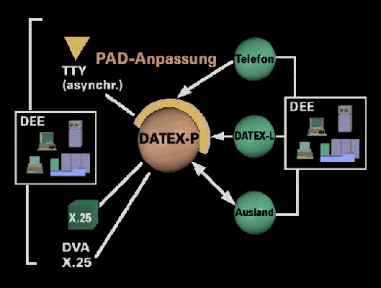datex packet switching network
Datex-P was a public data packet network with data packet switching operated by Deutsche Telekom. Datex-P's data packet switching worked with fixed-length packets, and long information had to be distributed over several individual packets according to its length. Each packet consisted of an address part and a data part.
The physical lines could be used several times by interleaving the data packets over time( multiplexing). Datex-P offered transmission speeds between 300 bit/s and 1,920 kbit/s, and up to 255 logical channels could be formed per connection. In addition to X.25, Datex-P supported X.28SNA architecture and frame relay. The fixed or dialed connections were only switched through logically; there were dial-through options for main connections with sub-addresses. In addition, closed user groups could be formed via Datex-P.
Datex-P offered fixed and dialed virtual connections as well as the option of connecting via satellite. Access from other networks was possible from ISDN, as well as from the analog telephone network and the mobile network.
Telekom provided user-specific connections, which it also designated accordingly. There was the Datex-P user connection, the connection for offices, for the SNA architecture, remote access and a Datex-P-Global X.25 connection. The Datex-P user connection operated at 9.6 kbit/s synchronously via X.25 and asynchronously via X.28. The office connection with the X. 20 and X.21interfaces operated at 19.2 kbit/s, synchronously with the X.25 protocol.
The Datex-P host connection was characterized by its high transmission rate. This was 64 kbit/s, but it could be increased N times. The maximum speed was 1.92 Mbit/s. The host connection also worked synchronously with the X.25 protocol.
With the Datex-P-Remote -Access it was possible to dial into the Datex-P network from the analog telephone network or from ISDN via a node. Access to telephone lines had a transmission speed of 14.4 kbit/s in duplex mode with synchronous transmission; with asynchronous transmission the speed was twice as high, i.e. 28.8 kbit/s.

